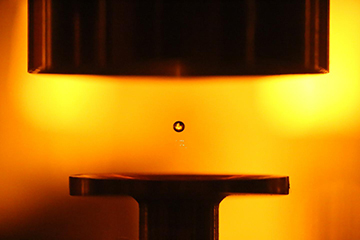
A research team in Mexico used sound waves to levitate droplets of water, and enable the liquid samples to be chemically analyzed for heavy-metal contaminants using laser-induced breakdown spectroscopy (LIBS). [Image: Jairo Peralta and Victor Contreras / Instituto de Ciencias Físicas, Universidad Nacional Autónoma de México]
A team of researchers from Mexico has developed a way to use laser-induced breakdown spectroscopy (LIBS), a technique commonly used to analyze solid samples, to detect very low concentrations of heavy metals in individual water droplets (Opt. Lett., doi: 10.1364/OL.43.002260). Using their technique, which employs acoustic-wave levitation to suspend and pre-concentrate the water droplets for more accurate chemical analysis, the researchers obtained reproducible measurements of minute quantities of barium, cadmium, mercury and lead in deionized water-based samples.
The team says that its LIBS technique could someday be used to quickly and affordably monitor water-supply quality and identify potential contamination in situ and in real time.
Not just for solids
LIBS, a decades-old method of atomic-emission spectroscopy, commonly involves vaporizing a small piece of a solid sample with a laser to create a plasma. This laser-induced plasma emits light spectra specific to the sample’s chemical makeup. Recent advances in miniaturizing LIBS equipment, and the fact that LIBS technology requires little to no sample prep, have led to its growing use in the field to provide real-time, solid-sample analysis.
Despite the growing number of LIBS applications, the technique is difficult to use for liquid-sample analysis. One reason is that a laser-induced plasma formed from a liquid cools down and disappears quickly, limiting the time window for capturing and measuring the plasma-emitted spectra. Another drawback is a liquid’s tendency to ripple, splash or form an aerosol when disturbed, which can scatter light and disrupt the spectra.
A potential solution to these two hurdles is drying the liquid sample for LIBS analysis on a solid substrate. Evaporating the liquid sample in this way concentrates the elements of interest and eliminates concerns associated with the liquid’s physical properties. However, laser pulses aimed at the dried sample residue could also excite atoms from the solid substrate, thereby muddying the results.
Acoustic-levitation LIBS
To find another way, a research team led by Victor Contreras, Instituto de Ciencias Físicas, Universidad Nacional Autónoma de México, used acoustic-wave levitation to suspend a water droplet sample for LIBS analysis in midair. Not only does levitating eliminate the problem of interference from a solid substrate, but the levitating droplet evaporates slightly, concentrating any chemicals it might contain. And, because the position of the droplet is a well-defined, small spot, a compact, cost-effective low-energy laser can be used to create the plasma.
Contreras and his team demonstrated their LIBS technique using water-based solutions containing small amounts of heavy metals. First, they place a water droplet in the node of an acoustic wave from a uniaxial levitator. Once levitated, the water droplet evaporates slightly, concentrating the heavy metals it contains and making them easier to detect via spectroscopy. Next, a Nd:YAG laser system delivers 532-nm pulses with a duration of 10 ns and 30 mJ of energy to the levitated pre-concentrated water droplet.
The laser pulses produce a plasma from the water droplet; that plasma, in turn, emits spectra that are collected by a plano-convex lens and focused into an optical fiber that’s coupled to a spectrometer and computer for chemical analysis. The entire process—from water droplet levitation to chemical identification—takes only a few minutes.
The researchers report detecting as little as 0.2 mg/L barium, 0.7 mg/L cadmium, 1.0 mg/L mercury and 2.0 mg/L lead in their water droplet samples, and were able to provide reproducible results on multiple trials. Contreras said in a press release that “an online analyzer based on our technique could one day help prevent environmental disasters and contribute to improved water quality control.”
The researchers are now working on ways to improve the technique’s instrumentation—for example, optimizing the mechanical design of the acoustic-levitation trap to provide more stable levitation conditions. They are also working to improve detection sensitivity by further reducing the size of the water droplet sample.
